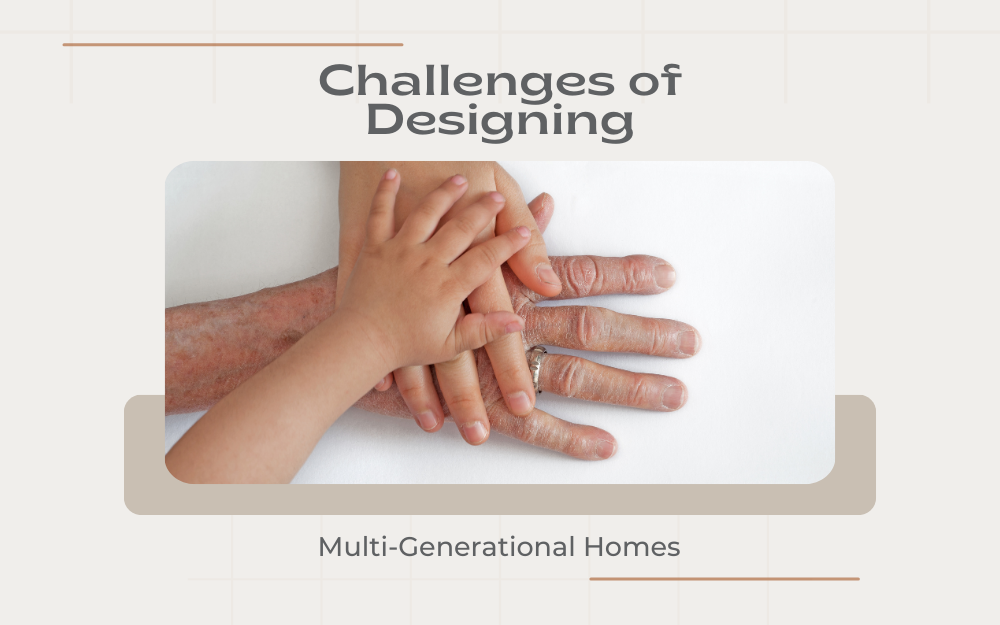
Challenges of Designing Multi-Generational Homes
February 17, 2025
- Balancing Privacy with Togetherness One of the biggest challenges in a multi-generational household is maintaining privacy while fostering family togetherness. While it’s important for each generation to have their own space, it’s also essential to design communal areas where family members can gather and spend time together.
Solution:- Separate Living Spaces: Consider creating distinct living areas within the home, such as a separate suite for older parents or adult children. This suite can include a private bedroom, bathroom, and sitting area to offer them independence while still being part of the family unit.
- Flexible Spaces: Use movable partitions or sliding doors to create flexible living spaces that can be closed off when needed and opened up for family activities.
- Designing for Mobility Needs As family members age, mobility becomes a significant factor in home design. Stairs can be challenging for older adults, and traditional bathrooms may not be accessible for those with limited mobility.
Solution:- No-Step Entryways: Design entryways without steps or with ramps for easy access to the home. Wide doorways and hallways also help make the space wheelchair accessible.
- Accessible Bathrooms: Incorporate features like walk-in showers with grab bars, elevated toilets, and lower countertops. Consider adding benches or stools in showers to improve safety and comfort.
- Wide Hallways and Doors: These allow for easier movement of wheelchairs, walkers, and strollers, providing everyone in the family with easier access to different areas of the home.
- Accommodating Different Lifestyles and Needs Different generations often have different needs when it comes to their daily routines and activities. A toddler might need a play area, while a grandparent may prefer a quiet nook for reading. Additionally, there are the varied work schedules and habits of adults in the home, which could make it tricky to balance everyone’s needs.
Solution:- Zoning the Home: Group spaces by function. For example, place the children’s bedrooms near the playroom or family room, while creating a quiet, retreat-style zone for older family members. Family gathering areas like the kitchen or living room should be spacious enough for multiple people to use at once without feeling cramped.
- Soundproofing: Consider using soundproofing materials in walls, ceilings, and floors to reduce noise between rooms. This can help keep the peace between family members who may have different schedules.
- Technology Integration: Smart home technology can help streamline daily life. For instance, automated lighting and thermostats can make the home more energy-efficient and accessible for older adults, while younger generations can benefit from high-speed internet and smart entertainment systems.
Designing for Multiple Generations: Key Considerations
- Shared Spaces That Encourage Family Time
- Large, Open Kitchens: A spacious kitchen with an island or open shelving invites family members to gather, cook together, or simply socialize while meals are being prepared.
- Flexible Dining Areas: Consider a dining area with ample seating, allowing for everyone to come together comfortably. Extendable dining tables or movable seating can accommodate larger groups.
- Living Rooms for All Ages: A central living room should be designed for comfort and flexibility. Cozy, but with plenty of seating options for children, adults, and seniors to share.
- Personalized Bedroom and Bathroom Spaces
- Separate Bedrooms: Bedrooms should cater to each individual’s needs. Parents may want a master suite with an ensuite bathroom, while children might enjoy a themed room or a shared space with creative, functional furniture.
- Multi-Functional Rooms: Consider rooms that can be adapted as children grow or as a parent’s needs change. Murphy beds, fold-away furniture, or multifunctional desks can maximize space.
- Outdoor Living Areas
- Multigenerational Outdoor Spaces: A patio, backyard, or deck area that accommodates family activities for all ages can bring everyone together. Outdoor spaces can serve as an extension of your home’s living area, offering a peaceful space for older generations while providing plenty of room for kids to play.
- Safety Features
- Lighting: Ensure all hallways, stairs, and paths are well-lit to prevent accidents, especially for older family members who may have trouble seeing at night.
- Non-Slip Surfaces: Use non-slip flooring materials in high-traffic areas such as the bathroom, kitchen, and entryways to prevent falls.
- Baby-Proofing: If young children are living in the home, it’s essential to childproof areas like stairs, cabinets, and sharp furniture edges.
Rewards of Multi-Generational Home Design
- Stronger Family Connections Living together under one roof strengthens family bonds and fosters a sense of togetherness. Children benefit from the wisdom and support of older generations, while seniors enjoy the companionship and care of their younger relatives.
- Shared Financial Benefits Multi-generational living can help reduce financial strain by allowing families to pool resources, share household expenses, and reduce the cost of living for everyone. This can be especially beneficial in today’s housing market.
- Long-Term Sustainability Designing a home that caters to multiple generations can help families navigate future challenges. A home that accommodates elderly parents can prevent the need for costly assisted living or nursing home services in the future. Similarly, children can grow into their space as they age, providing long-term flexibility.
Final Thoughts: Making Multi-Generational Living Work
Designing a multi-generational home requires careful planning to balance the unique needs and preferences of each family member. While the challenges can be significant, the rewards of creating a space where multiple generations can live together harmoniously are truly worth it. By incorporating flexible, functional, and thoughtful design elements, you can create a home that’s comfortable and practical for everyone, no matter their age. At Integrity Design and Remodel, we specialize in designing custom homes that meet the needs of families at all stages of life. If you’re considering a multi-generational remodel or design, reach out to us today to discuss how we can help you create a home that works for you and your loved ones.

No Comments
Sorry, the comment form is closed at this time.